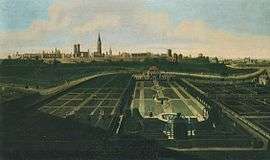Peter Jacob Horemans

Peter Jacob Horemans or Peter Jakob Horemans (October 26, 1700 – August 3, 1776) was a Flemish painter of genre scenes, portraits, conversation pieces, still lifes and city views. After training in Antwerp he was active in Germany where he became court painter.[1] He was a versatile artist who worked in many genres and for a variety of aristocratic, religious and private patrons.[2]
Life
Horemans was born in Antwerp as the son of a notary.[3] He was listed from 1716 until 1724 in the records (liggeren} of the Antwerp Guild of Saint Luke as the pupil of his older brother Jan Josef Horemans, a genre painter.[1]

In 1725 he moved to Munich. He became in 1727 court painter to prince-elector of Bavaria Charles Albrecht, the Emperor Charles VII, Holy Roman Emperor from 1740 to 1745. He made decorations in the prince-elector's Nymphenburg Palace and the hunting lodge Amalienburg.[3]
His nephew François Charles (Franz Karl) Horemans worked after 1725 in his workshop in Munich.[4] On 4 June 1730 he got married to Justina Magdalena Resch, daughter of the table decker of the prince-elector. His artist friends the court sculptors Guillielmus de Grof (or Willem de Grof) and Gilles Fareslitz attended the wedding.[3] In 1759 he became court painter to Maximilian III Joseph, the subsequent Elector of Bavaria. In 1765 he qualified as a master in Munich.[2]

The Nuremberg painter Magnus Prasch was his pupil.[1]
In his final years his eyesight deteriorated to the point that he could no longer paint. Horemans died in Munich.[3]
Work
Peter Jacob Horemans was a versatile artist who practised in many genres: genre scenes, conversation pieces, portraits, hunting scenes and city views.
His works provided an interesting record of everyday life in Munich during the Rococo period.[2]
References
- 1 2 3 Peter Jacob Horemans at the Netherlands Institute for Art History (Dutch)
- 1 2 3 Alain Jacobs. "Horemans." Grove Art Online. Oxford Art Online. Oxford University Press. Web. 13 August 2016
- 1 2 3 4 Frans Jozef Peter Van den Branden, Geschiedenis der Antwerpsche schilderschool, Antwerpen, 1883, p. 1192-1131 (Dutch)
- ↑ Charles Horemans at the Netherlands Institute for Art History (Dutch)
External links
 Media related to Peter Jacob Horemans at Wikimedia Commons
Media related to Peter Jacob Horemans at Wikimedia Commons